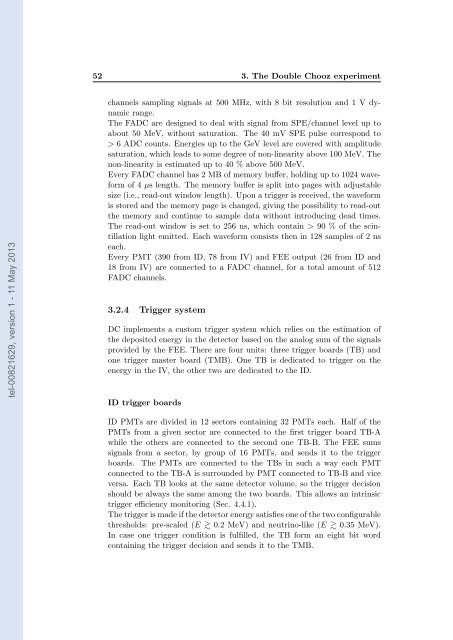Etude et impact du bruit de fond corrélé pour la mesure de l'angle ...
Etude et impact du bruit de fond corrélé pour la mesure de l'angle ...
Etude et impact du bruit de fond corrélé pour la mesure de l'angle ...
Create successful ePaper yourself
Turn your PDF publications into a flip-book with our unique Google optimized e-Paper software.
52 3. The Double Chooz experiment<br />
tel-00821629, version 1 - 11 May 2013<br />
channels sampling signals at 500 MHz, with 8 bit resolution and 1 V dynamic<br />
range.<br />
The FADC are <strong>de</strong>signed to <strong>de</strong>al with signal from SPE/channel level up to<br />
about 50 MeV, without saturation. The 40 mV SPE pulse correspond to<br />
> 6 ADC counts. Energies up to the GeV level are covered with amplitu<strong>de</strong><br />
saturation, which leads to some <strong>de</strong>gree of non-linearity above 100 MeV. The<br />
non-linearity is estimated up to 40 % above 500 MeV.<br />
Every FADC channel has 2 MB of memory bu↵er, holding up to 1024 waveform<br />
of 4 µs length. The memory bu↵er is split into pages with adjustable<br />
size (i.e., read-out window length). Upon a trigger is received, the waveform<br />
is stored and the memory page is changed, giving the possibility to read-out<br />
the memory and continue to sample data without intro<strong>du</strong>cing <strong>de</strong>ad times.<br />
The read-out window is s<strong>et</strong> to 256 ns, which contain > 90 % of the scintil<strong>la</strong>tion<br />
light emitted. Each waveform consists then in 128 samples of 2 ns<br />
each.<br />
Every PMT (390 from ID, 78 from IV) and FEE output (26 from ID and<br />
18 from IV) are connected to a FADC channel, for a total amount of 512<br />
FADC channels.<br />
3.2.4 Trigger system<br />
DC implements a custom trigger system which relies on the estimation of<br />
the <strong>de</strong>posited energy in the d<strong>et</strong>ector based on the analog sum of the signals<br />
provi<strong>de</strong>d by the FEE. There are four units: three trigger boards (TB) and<br />
one trigger master board (TMB). One TB is <strong>de</strong>dicated to trigger on the<br />
energy in the IV, the other two are <strong>de</strong>dicated to the ID.<br />
ID trigger boards<br />
ID PMTs are divi<strong>de</strong>d in 12 sectors containing 32 PMTs each. Half of the<br />
PMTs from a given sector are connected to the first trigger board TB-A<br />
while the others are connected to the second one TB-B. The FEE sums<br />
signals from a sector, by group of 16 PMTs, and sends it to the trigger<br />
boards. The PMTs are connected to the TBs in such a way each PMT<br />
connected to the TB-A is surroun<strong>de</strong>d by PMT connected to TB-B and vice<br />
versa. Each TB looks at the same d<strong>et</strong>ector volume, so the trigger <strong>de</strong>cision<br />
should be always the same among the two boards. This allows an intrinsic<br />
trigger e ciency monitoring (Sec. 4.4.1).<br />
The trigger is ma<strong>de</strong> if the d<strong>et</strong>ector energy satisfies one of the two configurable<br />
thresholds: pre-scaled (E & 0.2 MeV) and neutrino-like (E & 0.35 MeV).<br />
In case one trigger condition is fulfilled, the TB form an eight bit word<br />
containing the trigger <strong>de</strong>cision and sends it to the TMB.





![[tel-00726959, v1] Caractériser le milieu interstellaire ... - HAL - INRIA](https://img.yumpu.com/50564350/1/184x260/tel-00726959-v1-caractacriser-le-milieu-interstellaire-hal-inria.jpg?quality=85)










